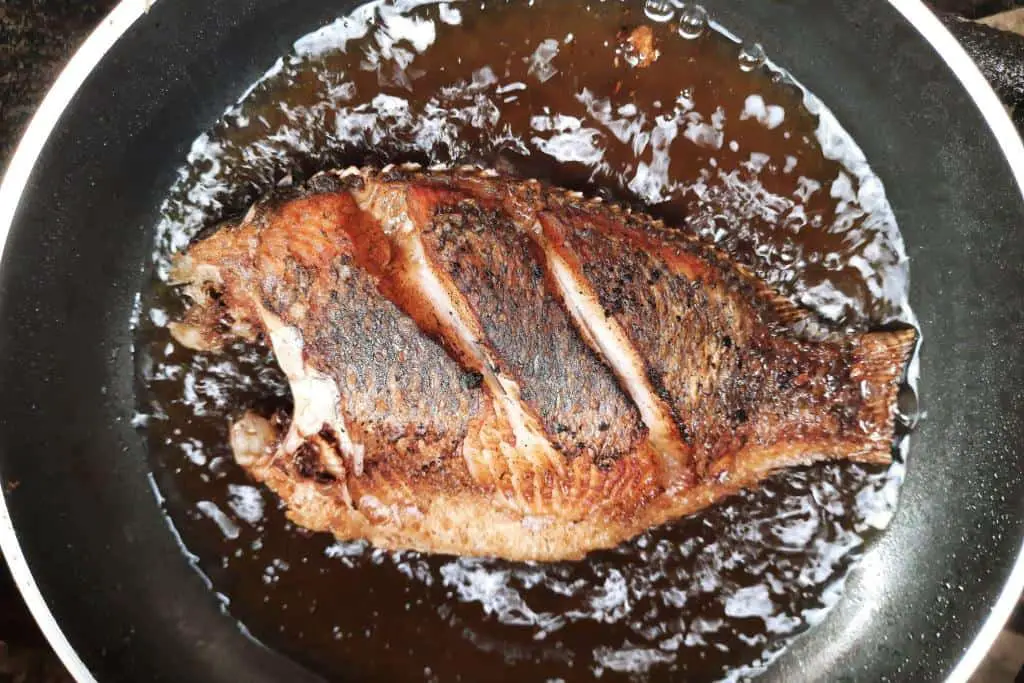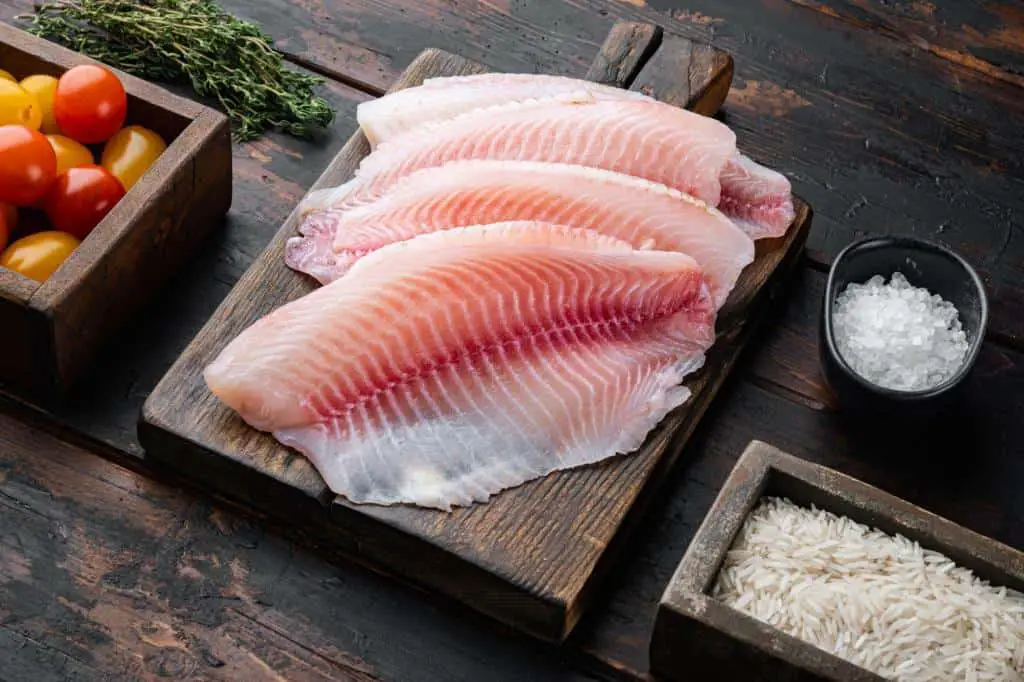Undercooked Tilapia: Can Eating Raw Tilapia Make You Sick?

When it comes to popular seafood choices, tilapia stands out as a versatile and nutritious option. Its mild flavor and delicate texture make it a favorite on dinner plates around the world. From grilled fillets to flavorful tacos, tilapia can be prepared in a variety of ways to satisfy diverse palates. However, there’s an important aspect of tilapia consumption that requires attention: Can eating raw tilapia make you sick?
From the appeal of sushi to the intrigue of sashimi, the idea of embracing the raw essence of seafood has grown into a global phenomenon. Yet, as we set our sights on that uncooked fillet of tilapia, a wave of caution crashed over us. Are there hidden perils beneath the surface, lurking within the flesh of this seemingly innocent fish?
Join us on a journey through the waters of culinary curiosity and scientific insight as we dive deep into the matter of undercooked tilapia and its potential impact on our well-being.
Introduction to Tilapia Consumption
Tilapia, a freshwater fish that hails from various regions globally, has gained popularity for its mild taste and ease of cooking. Native to freshwater environments, it’s bred in aquaculture settings worldwide.
The popularity of tilapia stems from its relatively low cost, easy cultivation, and neutral taste that adapts well to various flavor profiles. Tilapia, often dubbed the “aquatic chicken,” is known for its mild flavor and lean meat.
This fish is not only delicious but also packed with essential nutrients. Rich in protein, low in calories, and a good source of vitamins and minerals, tilapia offers a well-rounded nutritional profile. Moreover, its versatility in the kitchen allows for countless culinary creations, from simple lemon-butter preparations to complex marinades.
The Temptation and Risk of Raw Tilapia Delicacies
Sushi lovers have long relished the melt-in-the-mouth goodness of raw fish. However, not all fish are created equal when it comes to being served raw. While certain species, like tuna and salmon, are traditionally considered safe for raw consumption due to their lower risk of harboring harmful parasites, the same cannot be said for tilapia.
While tilapia is a delightful addition to any menu, the risk of undercooked consumption cannot be overlooked. When fish, including tilapia, isn’t cooked thoroughly, it can pose significant health risks. Raw or undercooked fish can harbor a variety of potentially harmful microorganisms, including bacteria and parasites. These organisms thrive in aquatic environments and can find their way into fish destined for consumption.
Common Pathogens and Parasites in Tilapia
Several microorganisms are commonly found in tilapia, especially when it’s undercooked or raw. Bacteria such as Salmonella and Vibrio and parasites like Anisakis can all take residence in improperly prepared fish. These microorganisms are not visible to the naked eye, making it even more crucial to ensure thorough cooking. Consuming undercooked tilapia that hosts these pathogens can lead to a range of health problems.
| Microorganism | Health Issues if Consumed |
| Salmonella | Gastrointestinal distress, fever, vomiting, and diarrhea |
| Vibrio | Gastrointestinal symptoms, skin infections if an open wound comes in contact |
| Anisakis | Allergic reactions, abdominal pain, vomiting |
Can Eating Raw or Undercooked Tilapia Make You Sick?

The consequences of consuming undercooked tilapia can be more than just a mild inconvenience. Depending on the microorganisms present, the health effects can range from mild to severe.
Symptoms often include food poisoning with nausea, vomiting, and diarrhea. In more serious cases, individuals might experience prolonged gastrointestinal distress, abdominal pain, and fever. Vulnerable populations, such as young children, the elderly, and individuals with compromised immune systems, are at a higher risk of severe complications.
How Do You Know if Tilapia Is Undercooked?
The answer lies in the interplay of sight and touch. As you stand by the stove, armed with your culinary instincts, grab a fork and approach the fish with confidence. Here’s your strategy:
- The Angle and Twist: Position the fork at an angle, gently piercing the thickest part of the fillet. Give it a subtle twist. If the flesh resists and doesn’t flake easily, it’s a sign that more cooking time is needed. But if the fish yields gracefully, revealing its delicate flakes, you’re on the right track.
- Translucence to Opacity: Observe the transformation. As tilapia cooks, it sheds its initial translucent or raw appearance. The hues shift from uncooked translucence to a desirable opaqueness, a visual confirmation that it’s nearing its culinary crescendo.
- The Temperature Test: While intuition is your ally, a digital thermometer adds precision. Aim for an internal temperature of 140–145 degrees Fahrenheit (60–63 degrees Celsius). This temperature sweet spot ensures your tilapia is not just safe to eat but also bursting with succulent flavors.
Preventing Undercooked Tilapia Consumption
To steer clear of the risks tied to undercooked tilapia, it’s important to adopt proper cooking practices. By following these guidelines, you can savor your tilapia while keeping potential health issues at bay:
- Cooking Temperatures: Ensure that your tilapia reaches an internal temperature of at least 145°F (63°C). This temperature is effective in destroying harmful microorganisms, guaranteeing that your fish is safe to eat.
- Visual Cues: A simple yet effective way to gauge tilapia’s doneness is by observing its appearance. When fully cooked, tilapia should turn opaque and easily flake with a fork.
- Other Methods of Determining Doneness: If you don’t have a food thermometer, you can use alternative methods. One common technique is to insert a fork into the thickest part of the fish and twist gently. If the flesh flakes apart, it’s done.
Safe Consumption Practices of Raw Fish
If you’re determined to explore the world of raw fish, there are ways to minimize the risks associated with raw tilapia consumption. Here’s a list of precautions to consider:
- Freshness is Key: In raw fish dishes, the quality and freshness of the fish are paramount. Expert chefs meticulously source the freshest fish and adhere to stringent storage guidelines to prevent contamination.
- Freezing: Freezing the tilapia at a temperature of -4°F (-20°C) for at least seven days can help kill parasites. However, this might not eliminate all types of parasites.
- Sourcing: Always opt for reputable sources when purchasing seafood. Ensuring that the fish has been handled and stored properly can reduce the risk of contamination.
- Sushi-Grade: If your heart is set on raw fish, look for tilapia labeled as “sushi-grade.” These fish are subject to stringent quality control measures to ensure they are safe for raw consumption.
- Home Storage: If you intend to prepare raw tilapia at home, freeze it for an adequate period to reduce the risk of parasites. Thaw it under refrigeration, not at room temperature, to avoid bacterial growth.
Balancing Taste and Safety in Tilapia Preparation
Achieving the perfect balance between delectable flavors and safe consumption is possible. Try these tips to enhance the taste of your tilapia while ensuring it’s cooked thoroughly:
- Marinades: Utilize flavorful marinades to infuse your tilapia with enticing tastes. Just remember that marinades won’t fully cook the fish, so ensure proper cooking afterward.
- Spices and Herbs: Experiment with a variety of spices and herbs to elevate the flavor profile of your tilapia dishes. Pairing tilapia with herbs like dill or parsley elevates its taste. Experiment with spices like paprika or cumin for an adventurous twist. These additions can complement the taste without compromising safety.
- Grilling: A smoky char and those coveted grill marks can transform tilapia into a delectable dish.
- Baking: Baking retains moisture, making it a healthy and fuss-free option.
- Pan-Searing: Achieve a crispy exterior and tender interior by searing tilapia on a hot pan.
The Bottom Line
Tilapia, with its higher risk of parasites and bacterial contamination, is not considered a safe option for raw consumption. The potential dangers of raw seafood, including undercooked tilapia, lurk in the form of parasitic and bacterial infections. The question “Is raw tilapia safe to eat?” prompts a resounding caution, directing our attention to the health implications of such a culinary choice.
In conclusion, while tilapia is undoubtedly a delicious and nutritious fish option, it’s crucial to ensure that it’s cooked thoroughly to eliminate potential health risks. The bottom line is that undercooked fish, including tilapia, poses substantial risks. To mitigate these dangers, safe cooking practices for tilapia should be your steadfast approach.
Embrace the transformational power of cooking techniques for tilapia. By taking precautions, sourcing responsibly, and experimenting with various methods, you can savor the best that tilapia has to offer while keeping your health intact. Instead of contemplating, “Can you get sick from eating undercooked tilapia?” you’ll confidently revel in your culinary creations, knowing you’ve shielded yourself from the bacterial and parasitic infections that accompany raw seafood.
So remember, while the allure of raw tilapia or undercooked fish may tempt your taste buds, the potential consequences of bacterial infections and parasitic ailments are far too great. Your journey to relishing the flavors of tilapia is rooted in responsible consumption, thorough cooking, and an unwavering commitment to your well-being.
FAQs on Can You Get Sick From Eating Undercooked Tilapia
Is it safe to eat tilapia raw?
Consuming raw tilapia comes with risks, as it can harbor harmful pathogens and parasites. Cooking thoroughly is recommended to ensure safety.
What are the symptoms of tilapia-related food poisoning?
Symptoms can range from mild gastrointestinal discomfort to severe vomiting, diarrhea, and potentially more serious complications.
Can I use marinades or citrus to “cook” tilapia ceviche-style?
While citrus or acidic marinades can alter the appearance of fish, they might not eliminate all pathogens. Cooking at appropriate temperatures is still advised.
Are there any alternatives to cooking to make tilapia safe to eat?
Freezing tilapia at very low temperatures for an extended period can kill some parasites, but it might not eliminate all risks associated with undercooked consumption.
What are the symptoms of tilapia-related food poisoning?
Symptoms can range from mild gastrointestinal discomfort to severe vomiting, diarrhea, and potentially more serious complications.






